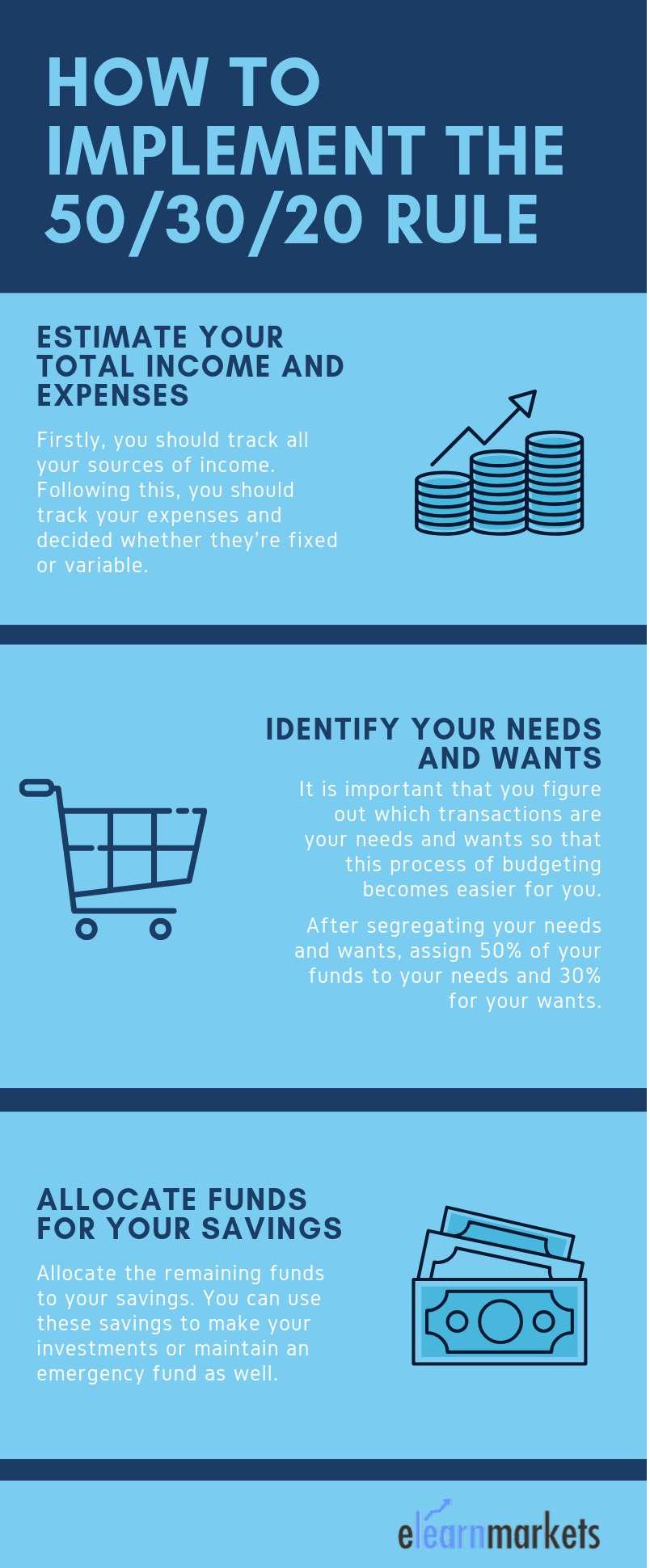Hindi: आप इस लेख को हिंदी में भी पढ़ सकते है|
The importance of maintaining a personal budget cannot be overstated.
It is the best way to allocate our funds towards our expenses, obligations and most importantly, savings.
| Table of Contents |
|---|
| What is the 50/30/20 Rule? |
| Needs and Wants |
| Why Should You Understand the Difference Between Your Needs and Wants? |
| How to Implement the 50/30/20 Rule? |
Despite all this, when it comes to budgeting, we are faced with a very tough question.
How do we start with this process in the first place?
It is in situations like these that we look for a rule of thumb, and the most popular one in this case is the 50/30/20 rule.
What is the 50/30/20 Rule ?
This rule states that we must allocate –
50% towards our needs;
30% towards our wants; and
20% towards our savings.
For example, if your total income is Rs. 10,000, allocate –
Manage your finances with Personal Finance for Beginners course by Market Experts
Rs. 5,000 towards your needs;
Rs. 3,000 for your wants; and
Rs. 2,000 towards your savings.
Needs and Wants:
To understand this rule any further, we first need to understand what are needs and wants.
Simply put, a need is something you cannot survive without.
Examples of needs include –
The rent for your house;
The food you eat; and
The loan repayments you have to make, etc..
Why is doing your loan repayment a need?
This is so because if you don’t put aside enough money for it, you may be penalized for late payment.
This will just add to your problems, and therefore, you need to make your loan repayment.
On the other hand, a want is something you don’t need, but simply desire.
Examples of wants include –
Eating out in restaurants;
Going out for movies;
Clubbing, etc..
Why Should You Understand the Difference Between Your Needs and Wants?
As we can see from the definition of the rule, 50% of your income will be allocated towards needs.
Now, suppose you habitually eat out thrice a month, and you have been doing this for three years.
When you sit down to make a budget, you might think that, since you have been eating out in this manner for so long, setting money aside for this is needed.
Therefore, will eating out be a part of your needs?
No. This is because eating out is not crucial to your survival, and therefore, it is not a need.
You first need to provide for the obligations you have towards your survival before you can provide for your wants.
Hence, for this rule to work for you, it is important for you to prioritize and act on your needs before your wants, always.
Now that we have discussed this, let us break down the 50/30/20 rule, step-by-step.
How to Implement the 50/30/20 Rule?
The steps to follow this rule are quite simple.

1. Estimate your total income and expenses.
To allocate your funds, you have to know how much funds you have.
Firstly, you should track all your sources of income.
You can earn income in the form of salary, along with some additional incomes in the form of rent, dividends, etc..
Following this, you must track your expenses, and understand which of these are –
Fixed (you need to make these payments); or
Variable (these may vary for every transaction).
2. Identify your needs and wants.
We have already discussed needs and wants and how to distinguish between them.
You will now put that knowledge into action and decide upon which of your transactions are your needs and wants accordingly.
After doing so, you should now set aside 50% of your funds for your needs, and 30% for your wants.
3. Allocate funds for your savings.
As we arrive to the last step, allocate the remaining money towards your savings.
Why should you set this money aside if you’re not using it at all? Why not spend it all?
This is because we never know what problems we might face in the future, and some extra money is always helpful in such cases.
You can also take help of Kredent Money App to allocate your funds for your savings
From medical emergencies to retirement planning, savings are the lifeline that can prevent us from being completely helpless when we face financial difficulties.
With the various financial products available to us today, we can make our savings generate more money for us as well. How?
We can put this money in –
A savings account; or
A recurring deposit; or
An investment in the stock market.
We can even use this money to create a separate fund for emergencies of any kind as well.
Learn how to invest your salary for Financial Independence –
The 50/30/20 rule is a popular thumb-rule that seems logical and is quite easy to follow as well.
One thing that you should always remember is, that it is not necessary that a rule which works for everyone else, works for you in the same way as well.
We all have different incomes, needs, wants and expenses, and this rule is merely a simple way of allocating funds.
Once you start budgeting, you will start to understand which type of allocation works for your financial profile accordingly.
Happy Learning!








